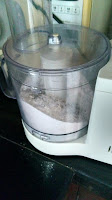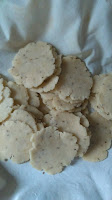My preference is variegated - top of the head would be, dal chawal, poori aloo, toast, coffee (welcome any time of the day). This list ticks all the boxes of what comfort food is synonymous with - childhood association - loaded with nostalgia.Truly satisfying and filling - nourishes and soothes the soul and most importantly what I turn to often and remain ever fond of ... So where does 'mathri' (salted crackers) fit into this food group, the crisp Indian savory with its faint 'ajwain' (carom) aftertaste, the perfect tea time snack. This is my go to snack, something which I crave most with my cup of tea. The perfect 'chai' and namkeen combo.
Making 'mathri' at home is a long standing tradition. I had seen my nani (maternal grandmother), and then my mother make it for us sisters. In my grandmother's times they were made a canister full and stored in the larder - for the big joint family.
When I visit my children, the process of making 'mathri' is spread over a few days as it is made in copious amount (it remains good for very long). It goes well with virtually any pickle and can be turned into a meal with 'sookhe aloo ki sabji' or say 'gobhi ki sabji'.
We are now exposed to multifarious cuisines - but these old favorites have a special place in the heart. We perhaps need to preserve these recipes, lest they get lost in new food trends.
Traditionally, mathri is made with refined flour, sometimes sooji (semolina) is mixed into the flour, a healthier alternative could be whole wheat flour. I am more of a purist and believe it is better to eat in moderation rather than compromising on the taste. My experiments with baking wholewheat crackers drew home the fact that they just don't taste the same as good old fried crackers

'Mathri', 'mathis' or 'suhaali', by whatever name you call them, are available at most namkeen shops but nothing beats the taste of home made ones. Till some time back I would knead the dough by hand but now the food processor does the grunt work and making them is now a breeze. So here are the proportions that I follow.
 'Mathri' (salted crackers)
'Mathri' (salted crackers)
500 grams all purpose flour (maida)
1 1/2 teaspoon carom seeds (ajwain)
5 tablespoon refined oil
Salt to taste
Water for kneading the dough
Oil for frying
Add the flour, salt, carom seeds in a bowl, rub in the oil into the flour and mix it well together (adding oil to the dough imparts a flaky crispness). Knead a stiff but pliable dough - stiffer than the poori dough. Once the dough comes together, make small walnut sized balls and roll them into 2-3"rounds, then prick each of these discs with a fork so that while frying they remain flat as in papdi.
 Heat oil in a wok, test the oil to see if it is hot enough then slide the rolled out rounds into the oil. Keep the flame on medium so that the 'mathris' get thoroughly cooked. Once they turn golden brown on one side then turn them over and fry till both sides take on a golden brown hue.
Heat oil in a wok, test the oil to see if it is hot enough then slide the rolled out rounds into the oil. Keep the flame on medium so that the 'mathris' get thoroughly cooked. Once they turn golden brown on one side then turn them over and fry till both sides take on a golden brown hue.
Drain them with a slotted spoon onto a plate, let them cool completely and then store in a glass jar. Enjoy these yummy savories at leisure.
I would love to hear about your comfort food and of course the stories associated with them - for in no less measure they add to the romance of our favorite food memories!
Making 'mathri' at home is a long standing tradition. I had seen my nani (maternal grandmother), and then my mother make it for us sisters. In my grandmother's times they were made a canister full and stored in the larder - for the big joint family.
When I visit my children, the process of making 'mathri' is spread over a few days as it is made in copious amount (it remains good for very long). It goes well with virtually any pickle and can be turned into a meal with 'sookhe aloo ki sabji' or say 'gobhi ki sabji'.
We are now exposed to multifarious cuisines - but these old favorites have a special place in the heart. We perhaps need to preserve these recipes, lest they get lost in new food trends.
Traditionally, mathri is made with refined flour, sometimes sooji (semolina) is mixed into the flour, a healthier alternative could be whole wheat flour. I am more of a purist and believe it is better to eat in moderation rather than compromising on the taste. My experiments with baking wholewheat crackers drew home the fact that they just don't taste the same as good old fried crackers

'Mathri', 'mathis' or 'suhaali', by whatever name you call them, are available at most namkeen shops but nothing beats the taste of home made ones. Till some time back I would knead the dough by hand but now the food processor does the grunt work and making them is now a breeze. So here are the proportions that I follow.
 'Mathri' (salted crackers)
'Mathri' (salted crackers) 500 grams all purpose flour (maida)
1 1/2 teaspoon carom seeds (ajwain)
5 tablespoon refined oil
Salt to taste
Water for kneading the dough
Oil for frying
Add the flour, salt, carom seeds in a bowl, rub in the oil into the flour and mix it well together (adding oil to the dough imparts a flaky crispness). Knead a stiff but pliable dough - stiffer than the poori dough. Once the dough comes together, make small walnut sized balls and roll them into 2-3"rounds, then prick each of these discs with a fork so that while frying they remain flat as in papdi.
 Heat oil in a wok, test the oil to see if it is hot enough then slide the rolled out rounds into the oil. Keep the flame on medium so that the 'mathris' get thoroughly cooked. Once they turn golden brown on one side then turn them over and fry till both sides take on a golden brown hue.
Heat oil in a wok, test the oil to see if it is hot enough then slide the rolled out rounds into the oil. Keep the flame on medium so that the 'mathris' get thoroughly cooked. Once they turn golden brown on one side then turn them over and fry till both sides take on a golden brown hue.Drain them with a slotted spoon onto a plate, let them cool completely and then store in a glass jar. Enjoy these yummy savories at leisure.
I would love to hear about your comfort food and of course the stories associated with them - for in no less measure they add to the romance of our favorite food memories!




